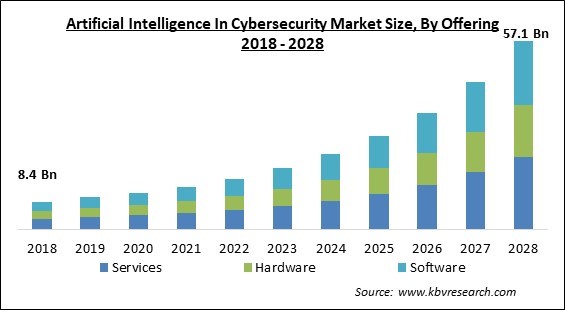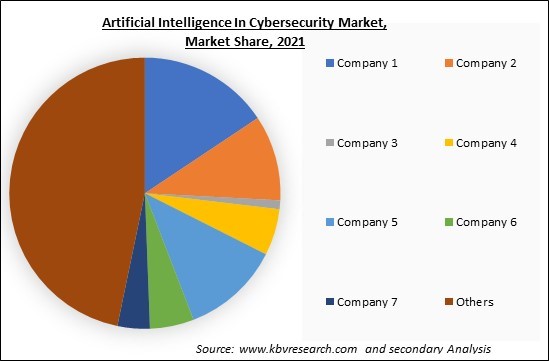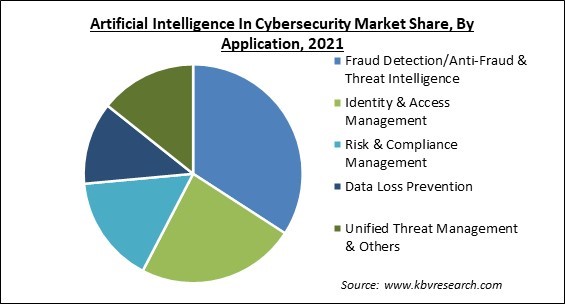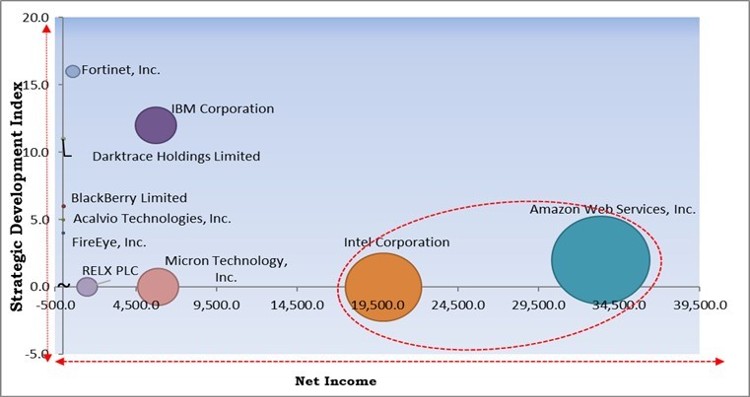The Global Artificial Intelligence In Cybersecurity Market size is expected to reach $57.1 billion by 2028, rising at a market growth of 24.5% CAGR during the forecast period.
The artificial intelligence in cybersecurity is an integration of the AI and cybersecurity sector in order to help enterprises in reducing their vulnerability risk while also strengthening their entire security posture. AI uses historical data to find patterns and trends in cyber security. Then, future attacks are predicted using this information.

AI-powered systems can be set up to automatically respond to dangers and combat online threats more quickly. Analyzing and improving cyber risks as well as cyber-attacks is no more a task on a human scale as the business attack surface develops and changes. To accurately quantify risk, up to highly-varying signals must be handled, based on the scale of the organization.
Neural networks as well as other AI tools and techniques have emerged in response to this unprecedented challenge to aid information security teams in protecting sensitive data, decrease the risk of breaches, and enhance their security posture through more efficient and effective threat detection as well as threat removal features.
Artificial intelligence (AI) is assisting under-resourced security tasks and operations analysts to keep ahead of threats as cyberattacks increase in volume and complexity. Artificial intelligence (AI) technologies, like machine learning or natural language processing, curate threat intelligence from various historical databases, blogs, and news articles to offer quick insights to break through the congestion of daily alerts, significantly lowering response times.
Widespread frauds involving the novel coronavirus and the spoofing of official institutions, like the WHO, present additional difficulties for organizations. For instance, Google discovered a very significant number of malware and phishing emails each day involving COVID-19 frauds during the initial 2020. In order to protect servers and databases from such hazards, the adoption of Artificial Intelligence in cybersecurity increased at a very rapid pace. Therefore, the growth of the Artificial Intelligence in cybersecurity market was propelled during the COVID-19 pandemic.
Nowadays, a significant portion of internet traffic is made up of harmful bots. Bots can be a serious threat, causing everything from account takeovers using stolen passwords to phony account creation as well as data fraud. Automated threats cannot be countered solely through manual reactions. With the aid of AI and machine learning, it is possible to differentiate between good bots (such as search engine crawlers) and bad bots as well as between humans and website visitors.
The IT asset inventory, which is a precise and thorough list of all users, devices, and apps with various levels of access to different systems, is determined with the use of AI algorithms. AI-based solutions may now estimate how and where companies are most susceptible to being attacked based on the asset inventory or threat exposure, allowing them to plan and direct resources to regions with the greatest risks.

The leading players in the market are competing with diverse innovative offerings to remain competitive in the market. The below illustration shows the percentage of revenue shared by some of the leading companies in the market. The leading players of the market are adopting various strategies in order to cater demand coming from the different industries. The key developmental strategies in the market are Product Launches.
The adoption of artificial intelligence is exponentially increasing all over the world. Artificial intelligence has been employed to evaluate creditworthiness, identify faces, and forecast weather. At the same time, the sophistication of hacks has increased while adopting stealthier techniques. Given that all industries were looking for better tools and innovative uses for their technology, the fusion of AI and cybersecurity seemed inevitable.
Based on Type, the Artificial Intelligence in Cybersecurity Market is segmented into Network Security, Endpoint Security, Vertical Security, and Cloud Security. In 2021, the endpoint segment recorded a significant revenue share of AI in cybersecurity market. Organizations will push for continuous monitoring and risk-based application management, and automatic classification of the AI-based endpoint security. Endpoint security solutions frequently generate an allow list based on well-known software and a refuse list based on well-known malware automatically.

On the basis of Offerings, the Artificial Intelligence in Cybersecurity Market is segregated into Hardware, Software, and Services. In 2021, the services segment procured the largest revenue share of the Artificial Intelligence in cybersecurity market. The market for Artificial Intelligence in cybersecurity is anticipated to expand significantly due to the segment. The market's expansion will be fueled by a strong need for application programming interfaces that include machine learning methods, speech, sensor data, and vision.
By Technology, the Artificial Intelligence in Cybersecurity Market is classified into Machine Learning, Natural Language Processing (NLP), and Context-aware computing. In 2021, the machine learning segment witnessed the highest revenue share of the Artificial Intelligence in cybersecurity market. With deep learning becoming increasingly prevalent across end-use sectors, machine learning technology would experience rapid growth. Leading businesses have been employing machine learning for threat identification and email filtering.
Based on Application, the Artificial Intelligence in Cybersecurity Market is categorized into Identity & Access Management, Risk & Compliance Management, Data Loss Prevention, Unified Threat Management, and Fraud Detection/Anti-Fraud & Threat Intelligence. In 2021, the unified threat management segment registered a significant revenue share of the Artificial Intelligence in cybersecurity market. In order to stop email phishing, fraud, and phony records, AI techniques may become more popular. Unified threat management (UTM) has gained more momentum with businesses as a way to safeguard their digital assets from dangers like spyware-infected files, phishing scams, unauthorized website access, and trojans.
By Vertical, the Artificial Intelligence in Cybersecurity Market is divided into BFSI, Retail, Government & Defense, Manufacturing, Enterprise, Healthcare, and Others. In 2021, the BFSI sector procured a significant revenue share of the Artificial Intelligence in cybersecurity market. Industry insiders anticipate that the deployment of AI in the fintech industry will increase the market share of AI in cybersecurity. The adoption of AI-based solutions to detect and recognize financial crimes and fraud is largely credited for the reliable projection.
| Report Attribute | Details |
|---|---|
| Market size value in 2021 | USD 12.8 Billion |
| Market size forecast in 2028 | USD 57.1 Billion |
| Base Year | 2021 |
| Historical Period | 2018 to 2020 |
| Forecast Period | 2022 to 2028 |
| Revenue Growth Rate | CAGR of 24.5% from 2022 to 2028 |
| Number of Pages | 388 |
| Number of Tables | 603 |
| Report coverage | Market Trends, Revenue Estimation and Forecast, Segmentation Analysis, Regional and Country Breakdown, Competitive Landscape, Market Share Analysis, Companies Strategic Developments, Company Profiling |
| Segments covered | Offering, Type, Application, Vertical, Technology, Region |
| Country scope | US, Canada, Mexico, Germany, UK, France, Russia, Spain, Italy, China, Japan, India, South Korea, Singapore, Malaysia, Brazil, Argentina, UAE, Saudi Arabia, South Africa, Nigeria |
| Growth Drivers |
|
| Restraints |
|
Region-Wise, the Artificial Intelligence in Cybersecurity Market is analyzed across North America, Europe, Asia-Pacific, and LAMEA. In 2021, North America accounted for the maximum revenue share of the artificial intelligence in cybersecurity market. The increase in network-connected devices brought on by the adoption of IoT, 5G, and Wi-Fi 6 is primarily attributed to the growth of the regional market. The expansion of the 5G network has been driven by businesses in the automotive, government, healthcare, energy, and mining industries, which might be a point of access for hackers.
Free Valuable Insights: Global Artificial Intelligence In Cybersecurity Market size to reach USD 57.1 Billion by 2028

The major strategies followed by the market participants are Product Launches. Based on the Analysis presented in the Cardinal matrix; Amazon Web Services, Inc. and Intel Corporation are the forerunners in the Artificial Intelligence In Cybersecurity Market. Companies such as IBM Corporation, Micron Technology, Inc., Fortinet, Inc., are some of the key innovators in Artificial Intelligence In Cybersecurity Market.
The market research report covers the analysis of key stake holders of the market. Key companies profiled in the report include IBM Corporation, Amazon Web Services, Inc., FireEye, Inc., BlackBerry Limited, Fortinet, Inc., Intel Corporation, RELX PLC, Micron Technology, Inc., Acalvio Technologies, Inc., and Darktrace Holdings Limited.
By Offering
By Vertical
By Application
By Type
By Technology
By Geography
The global Artificial Intelligence In Cybersecurity Market size is expected to reach $57.1 billion by 2028.
Ensures a Higher Level Of Security From Bot Attacks And Spam are driving the market in coming years, however, Increasing Prevalence And Complexities Of Data Poisoning restraints the growth of the market.
IBM Corporation, Amazon Web Services, Inc., FireEye, Inc., BlackBerry Limited, Fortinet, Inc., Intel Corporation, RELX PLC, Micron Technology, Inc., Acalvio Technologies, Inc., and Darktrace Holdings Limited.
The expected CAGR of the Artificial Intelligence In Cybersecurity Market is 24.5% from 2022 to 2028.
The Enterprise segment acquired maximum revenue share in the Global Artificial Intelligence In Cybersecurity Market by Vertical in 2021 thereby, achieving a market value of $13 billion by 2028.
The North America market dominated the Global Artificial Intelligence In Cybersecurity Market by Region in 2021, and would continue to be a dominant market till 2028; thereby, achieving a market value of $20.8 billion by 2028.
Our team of dedicated experts can provide you with attractive expansion opportunities for your business.

